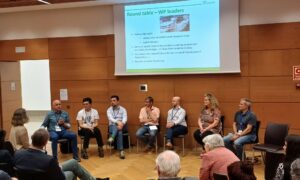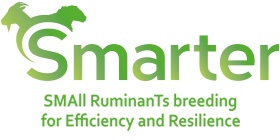
This project has received funding from the European Union’s Horizon 2020 research and innovation programme under grant agreement No 772787.
Final SMARTER Meeting – Toledo 2023!
– by R. Rupp and R. Bica
The H2020 SMARTER project, an ambitious EU-funded endeavour, recently held the concluding meeting in Toledo, Spain on May 22-23, 2023. The meeting brought together the project’s work package (WP) leaders, project partners and stakeholders to review the progress made, identify remaining tasks, and discuss the roadmap for the project’s final phase leading up to its scheduled completion in June 2023. A total of 69 people attended the conference, 59 of which were project partners coming from the institutions involved, and 10 were stakeholdersThe SMARTER project, which stands for “SMAll RuminanTs breeding for Efficiency and Resilience,” is a collaborative effort involving multiple European and international institutions, industry partners, and research organizations. Started in 2018, the project sought to study how genetic selection can help to increase resilience and efficiency in small ruminants (sheep and goats) in their environments and across a range of diverse environments. Each work package (WP1-8) discussed their main achievements from the start of the project until now and what the key take home points are. For WP1 (efficiency), many proxies and predictors were tested for feed efficiency. However, since feed efficiency is a complex trait, it is hard to predict with proxies without the inclusion of information on intake. A possible link between feed efficiency and milk fat in dairy breeds could be a route to take in future work, however more work needs to be done to provide any conclusive results with regards to this. With regards to WP2 (resilience), the major highlights were the first genomic breeding values obtained for footrot and mastitis in UK Texel sheep, the first genome-wide study on the genetic architecture of lifetime resilience in Chios sheep, and the discovery of several homozygous deficiency regions associated with early survival in 3 dairy sheep breeds. The third WP, which focused on the trade-offs between efficiency and resilience, showed how no major systematic antagonisms between R&E were detected (from different approaches developed in WP3, including metanalyses and modelling) which is good news as it will allow balancing selection for both resilience and efficiency in future work in the field. The highlight of WP4 which focused on the genomic characterisation of under-utilised breeds, was the collaborative effort from the partners in the WP to produce a sizeable online data repository composed of both foreground and background data to facilitate characterisation analyses. WP5, one of the most technical WP’s of the project, has produced several publications, but one in particular: ‘Semi-parametric estimates of population accuracy and bias of predictions of breeding values and future phenotypes using the LR method’ by Andres Legarra and Antonio Reverter is set to become a benchmark paper. Other methods developed in WP5 are under consideration (metafounders, genomic inbreeding) and others have large potential to be adopted in practical breeding programmes. (e.g. detection of stress). The work done in WP6 produced the first across country evaluation methodology for small ruminants, highlighting its weaknesses and strengths and potential for future growth. This is a major achievement based on international cooperation which will improve and increase the speed at which small ruminant research can be done. On top of this, a list of common SNPs panels was identified and illustrated how it is possible compare SNPs coming from different populations. WP7 focused on balanced-breeding goals for agro-ecological resilience. Simulations were used to assess different farm scenarios under different conditions to select for R&E traits with results showing that with the SMARTER model, economic performances of farms were improved, production was increased and management by the farmer was not have to be altered. Surveys were also sent to breeders and stakeholders which furthered the understanding of their trait preferences and  their view on what the optimal animal could look like. These models and surveys could really be useful to select optimal conditions/traits which can deal with the challenges of the future. And finally, WP8, the communications WP of the project, successfully achieved all of its planned activities, including the 10 round tables in 10 partner countries and the summer school, both of which had very positive feedback from those who attended, and information of which can all be found on the SMARTER website. In addition to reviewing the project’s progress and discussing the remaining tasks, the meeting concluded with an insightful round table discussion among the WP leaders regarding the accomplishments of the SMARTER project. They reflected on the various achievements and milestones reached throughout the project’s duration, acknowledging the positive impact their collective efforts had on addressing societal challenges. The participants also explored potential opportunities beyond the project’s completion, brainstorming ideas for further utilisation and expansion of the project outcomes. Overall, the project was completed in a period of 56 months, involved 27 partners with more then 120 scientists from 13 different countries, so it really was a team effort to complete it. Especially due to the fact that the project was impacted by the covid pandemic, which significantly slowed down some practical work, as well as the death of Carole Moreno-Romieux, the person who had the idea to start SMARTER and brought it to life. The SMARTER project therefore embodies the image of Carole and shows the ability she had to bring together groups and skills to face major challenges. All of the people involved in SMARTER will continue to work on developing an eco-friendlier and environmentally respectful small ruminant production system, thus ensuring that Carole’s dream is achieved. Please follow this link which will allow you to see the brilliant scientist that she was. Most collaborations developed in the project are still operational which bodes well for the continuation of the work beyond SMARTER. The impact of SMARTER is poised to resonate well beyond its completion, driving sustainable innovation and progress in the field of small ruminants in Europe and beyond.
their view on what the optimal animal could look like. These models and surveys could really be useful to select optimal conditions/traits which can deal with the challenges of the future. And finally, WP8, the communications WP of the project, successfully achieved all of its planned activities, including the 10 round tables in 10 partner countries and the summer school, both of which had very positive feedback from those who attended, and information of which can all be found on the SMARTER website. In addition to reviewing the project’s progress and discussing the remaining tasks, the meeting concluded with an insightful round table discussion among the WP leaders regarding the accomplishments of the SMARTER project. They reflected on the various achievements and milestones reached throughout the project’s duration, acknowledging the positive impact their collective efforts had on addressing societal challenges. The participants also explored potential opportunities beyond the project’s completion, brainstorming ideas for further utilisation and expansion of the project outcomes. Overall, the project was completed in a period of 56 months, involved 27 partners with more then 120 scientists from 13 different countries, so it really was a team effort to complete it. Especially due to the fact that the project was impacted by the covid pandemic, which significantly slowed down some practical work, as well as the death of Carole Moreno-Romieux, the person who had the idea to start SMARTER and brought it to life. The SMARTER project therefore embodies the image of Carole and shows the ability she had to bring together groups and skills to face major challenges. All of the people involved in SMARTER will continue to work on developing an eco-friendlier and environmentally respectful small ruminant production system, thus ensuring that Carole’s dream is achieved. Please follow this link which will allow you to see the brilliant scientist that she was. Most collaborations developed in the project are still operational which bodes well for the continuation of the work beyond SMARTER. The impact of SMARTER is poised to resonate well beyond its completion, driving sustainable innovation and progress in the field of small ruminants in Europe and beyond.


